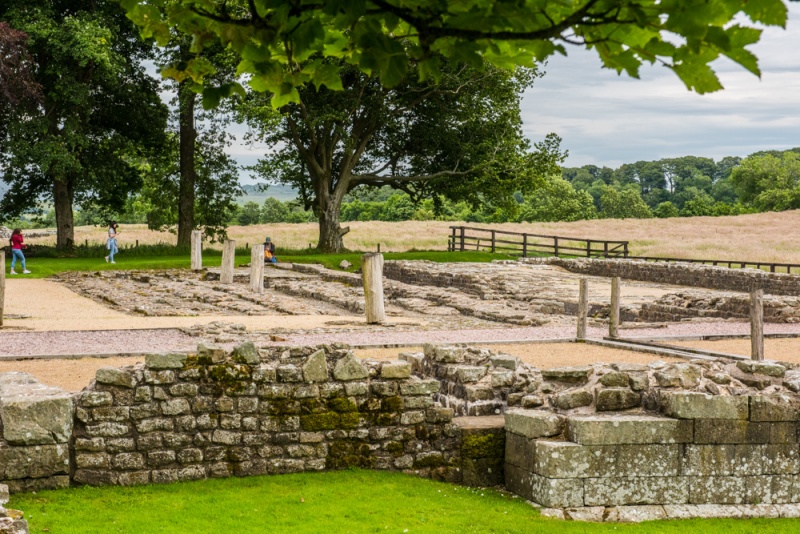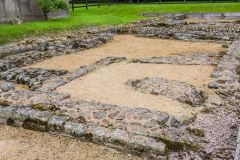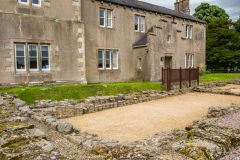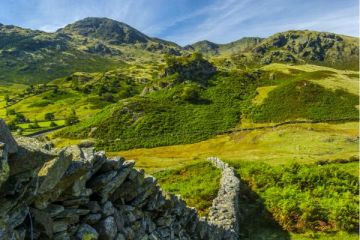
Birdoswald was a major Roman military fort built to protect Hadrian's Wall and a crossing of the River Irthing. There is also a Neolithic burial on the site, and the remains of an Anglo-Saxon hall can be seen. Birdoswald has also been traditionally associated with Camlan, the legendary site of King Arthur's last battle.
The fort is remarkably complete and offers an enjoyable glimpse of life on the Roman frontier long ago. The site covers about 5 acres on high ground above the river gorge, and remains of the early turf wall which preceded Hadrian's Wall are clearly visible.
Birdoswald is laid out on the traditional Roman plan, as a rectangle with rounded corners, rather like a modern playing card in shape. There was an angle tower at each corner and 4 main gates flanked by towers.
Perhaps the most interesting and unique feature at Birdoswald is a drill and exercise hall, now partly covered by the later farmhouse and visitor centre. This is the only drill hall found at any Roman auxiliary fort throughout the entire Roman Empire. The drill hall was created so that soldiers could train during the wet and windy conditions often encountered on the frontier of their new province of Britannia.
Only the south wall of the drill hall is visible, however the entire hall has been excavated, so archaeologists know a lot about it. The hall was a rectangle about 48 x 16 metres, built on a basilica plan, with a central nave and side aisles created by arcades of pillars. Light was admitted by windows set high on the aisle walls, like the clerestory windows you can see in some large medieval churches.
Also in front of the farmhouse is a blacksmith's workshop.

A visitor centre on the site houses displays which trace the history of the fort, Hadrian's Wall, and border raids in the medieval period.
Finds from the excavations at Birdoswald are on display at the Tullie House Museum in Carlisle.
History
The fort at Birdoswald was built shortly after Hadrian's Wall was begun in AD 122. It was garrisoned by an auxiliary infantry cohort consisting of 800 men, and remained in use throughout the period of Roman occupation in Britain. As with other large forts, a civilian settlement grew up outside the fort walls. This settlement, or vicus, consisted of stone houses laid out on a system of streets.
The site stands just west of a major crossing of the River Irthing. West of the Irthing Hadrian's Wall was built in turf, though the turf wall was later rebuilt in stone. The first fort was cut through the turf wall. The fort was begun as a timber and turf fortification, but the timber defences were not completed before it was completely rebuilt in stone. The stone fort was completed around AD 138.
We do not know which cohort formed the first garrison, but we do know that after the reign of Antoninus Pius (AD 138–161) the fort was garrisoned by the first cohort of Dacians, from what is now Romania. The Dacians remained at Birdoswald throughout the 3rd and 4th centuries.
A large number of inscribed stones, such as altars, tombstones, and building stones were left behind by the Dacians. The last inscribed stone found at Birdoswald dates to the late 3rd century. It records the rebuilding of the commander's house. The lack of inscribed stones from the 4th century is probably down to such stones becoming less popular during that period.
The site was gradually abandoned after the departure of the Roman legions in the early 5th century, though excavations reveal that the Roman site was used well into the so-called Dark Ages that followed the Roman occupation. Hall houses were built on the site of the Roman granaries, and the fort remained in use until at least the 6th century.
From the medieval period the site was part of a working farm, and cows grazed where the fort once stood. A bastle house (a fortified residence) was built here in the 16th century and the site was raided on at least 3 occasions by Reivers including members of the notorious Armstrong, Nixon, and Elliot families. A collection of farm buildings were built during the 17th and 18th centuries and these have been incorporated into the modern museum and visitor centre facilities.
In the 1840s the Birdoswald estate was bought by Henry Norman. Norman became interested in the history of his new property, and began to excavate the Roman remains. He called in archaeologiss from Newcastle to excavate the perimeter wall and major gateways. The archaeologists uncovered the commander's house and his personal bath suite, where they found a carved figure of the godess Fortuna.
Norman took advantage of the Roman remains; he used the foundation wall of the fort granary to create a ha-ha, or hidden wall. He also rebuilt the farmhouse in mock medieval style. Norman loved Birdoswald so much that he named his son Oswald after the fort.
Oswald Norman seems to have felt less love for his home; he auctioned the property in 1901 and sold the Roman artefacts his father had unearthed to the Tullie House Museum in Carlisle, where they can be seen today.
More to see:
Immediately east of the fort is a wonderfully preserved stretch of Hadrian's Wall, leading to Milecastle 49 (Harrow's Scar). The Hadrian's Wall Path leads past the milecastle, then descends the steep escarpment to a striking modern footbridge over the River Irthing to Willowford Roman Bridge abutment; the remains of the original Roman bridge over the river.
Our family has taken this walk several times and it is simply wonderful, especially on a golden summer evening, when the bank of the River Irthing is an idyllic place to linger.
Visiting
Birdoswald is located on a minor road just west of Gilsland village, off the A69 and B6318. The site is very well signposted, and is located directly on the Hadrian's Wall Path long-distance trail.
There is a large pay and display parking area operated by Northumberland National Park. The parking charge is rather steep, but you can get the fee refunded at the English Heritage visitor centre. The parking ticket also allows you free parking for 24 hours at other National Park lots along Hadrian's Wall, including Housesteads and Brocolitia.
About Birdoswald
Address: Gilsland,
Brampton,
Hadrian's Wall,
Cumbria,
England, CA8 7DD
Attraction Type: Roman Site
Location: 7 miles NE Brampton off B6318
Website: Birdoswald
English Heritage - see also: English Heritage memberships (official website)
Location
map
OS: NY620 666
Photo Credit: David Ross and Britain Express
HERITAGE
 We've 'tagged' this attraction information to help you find related historic attractions and learn more about major time periods mentioned.
We've 'tagged' this attraction information to help you find related historic attractions and learn more about major time periods mentioned.
Historic Time Periods:
Find other attractions tagged with:
Roman (Time Period) -
NEARBY HISTORIC ATTRACTIONS
Heritage Rated from 1- 5 (low to exceptional) on historic interest
Harrows Scar Milecastle (Hadrian's Wall) - 0.1 miles (Roman Site) ![]()
Willowford Roman Bridge (Hadrian's Wall) - 0.2 miles (Roman Site) ![]()
Willowford (Hadrian's Wall) - 0.4 miles (Roman Site) ![]()
Poltross Burn Milecastle (Hadrian's Wall) - 0.9 miles (Roman Site) ![]()
Thirlwall Castle - 2.4 miles (Castle) ![]()
Leahill Turret and Piper Sike Turret (Hadrian's Wall) - 2.5 miles (Roman Site) ![]()
Bank's East Turret (Hadrian's Wall) - 2.8 miles (Roman Site) ![]()
Pike Hill Signal Tower (Hadrian's Wall) - 2.9 miles (Roman Site) ![]()










